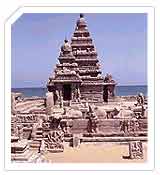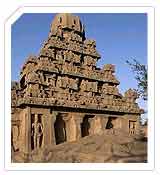|
|
|
|
|
|
|
Home » South
India » Tamilnadu » Mahabalipuram
|
|
|
|
Back
» Mahabalipuram
|
|
|
|
 Mahabalipuram in the south Indian state of Tamil Nadu is a pleasant seaside resort with some ancient relics embellishing its sea shore. The major attraction for the tourist lies in the bewildering Monolithic monuments and stone sculptures. The important monuments are the five Raths, the Bas-Relief on a huge rock popularly known as Arjuna's penance. The Mahisasura Mandapam, the Krishna Mandapam and the Shore Temple are other major attractions here. Mahabalipuram in the south Indian state of Tamil Nadu is a pleasant seaside resort with some ancient relics embellishing its sea shore. The major attraction for the tourist lies in the bewildering Monolithic monuments and stone sculptures. The important monuments are the five Raths, the Bas-Relief on a huge rock popularly known as Arjuna's penance. The Mahisasura Mandapam, the Krishna Mandapam and the Shore Temple are other major attractions here.
Sightseeing at Mahabalipuram -
Arjuna's Penance : Arjuna's Penance, 27 mtrs long and 9 mtrs high, is a colossal relief made on two huge boulders. It is perhaps the world's largest bas-relief, a universe itself in stone. The cleft in the rock describes the descent of the Ganga, brought to earth by King Bhagiratha to emancipate the cursed souls of his forefathers. The two large elephants are notable for their artistic beauty, and so are the images from the Panchatantra. Amongst the images are a forest with tribal people and all forms of animal life, just as they would appear in their habitat. Also, the images presents women clothed in an aura of ineffable grace, a rich inner beauty transfiguring the plainest of them. The entire picture has a delicate edge of humor. Accordingly positioned against the ascetic is a cat doing rigorous penance too.
Caves : The Varaha Cave, a small rock-cut mandapam (hall), is a faceted and finished gem with two incarnations of Vishnu-Varaha (boar) and Vamana (dwarf). Particularly remarkable here are four panels of the famous Pallava doorkeepers. There is about them a mood of contemplative reverie, a lyrical softness and subtle grace totally at variance with the primordial machismo their role as guards of the gods imposes on them. The Mahisasurmardini Cave (17th century) has fine bas-reliefs on its panels of endless beauty. The Dharmaraja Cave, built in the early 7th century, consists of three empty shrines. The Somaskanda sculpture transmits peace, power, and wisdom while Lord Vishnu is displayed in omniscient repose in a masterpiece of dhwani (the art of suggestion). On the opposite side is a huge theatrical panel portraying, Goddess Durga's fight with the demon Mahishasura, an episode culled from the celebrated Sanskrit poem Devi Mahatmya. About 5 km north of Mahabalipuram is another cave called Tiger Cave, a rock-cut shrine possibly dating back to 7th century.
 The Rathas : A group of structures lying at the southern extreme of Mahabalipuram, amidst the casuarina grove, are the famous Rathas (chariots). Known as the Pancha Pandava Rathas, these Rathas are five in number. Out of these, four are carved out of a single rock, while the fifth on the west is scooped out from a small rock. The square Draupadi and Arjuna Rathas, the linear Bhima Ratha, the taller Dharamraja Ratha and the apsidal Nakula-Sahadeva Ratha, constitute the complex. The Rathas : A group of structures lying at the southern extreme of Mahabalipuram, amidst the casuarina grove, are the famous Rathas (chariots). Known as the Pancha Pandava Rathas, these Rathas are five in number. Out of these, four are carved out of a single rock, while the fifth on the west is scooped out from a small rock. The square Draupadi and Arjuna Rathas, the linear Bhima Ratha, the taller Dharamraja Ratha and the apsidal Nakula-Sahadeva Ratha, constitute the complex.
Krishna Mandapam : The Krishna Temple is one of the earliest rock-cut temples of Mahabalipuram. The walls of the temples reflects scenes of pastoral life, one with the image of Krishna lifting the Govardhan Hill in his fingertips to protect his people from Indra.
Shore Temple : The Shore Temple at the Mahabalipuram sea-shore is the ultimate expression of Mahabalipuram. A three-in-one abode of God - a Vishnu temple positioned between two Shiva temples, is a treat to the eyes with its surroundings plentiful in architectural grandeurs. On either side of it is the sea spreading endlessly and infinitely. The complex wall of this temple is decorated with charming sculptures of Nandi the bull, while the figure of Vishnu is present in the sanctum sanctorum.
|
|
|
|
|
| |
|
|
|
|


